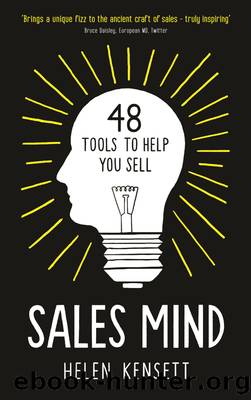Sales Mind by Helen Kensett

Author:Helen Kensett
Language: eng
Format: epub
Publisher: Profile Books
Example 1
Working with an international PR firm offering a whole host of communication services to the market, we needed to extract the hook for their buyers: heads of marketing and heads of PR in large blue-chip firms.
The ABI revealed that our clientâs central goal was increasing direct sales. This was the linchpin but not necessarily the hook. The secondary goals included upping media coverage, recognising the need for heightened impact in a market experiencing high competition for share of voice. This was coupled with another secondary need for measurement of any creative endeavour. All these together made up the hook.
The PR agencyâs what was the technology at the centre of all of their work, which had the unique capability of being able to scan the online media landscape and uncover any gaps relevant for their buyer.
The why was that this unique information enabled their clientâs content and messages to plug these gaps in the media, which in turn maximised press coverage and informed creative direction. The unique tool also measured changes in volume of coverage, allowing for accurate reporting.
This is one of the hooks we used:
âThe unique software enables you to uncover the gaps in your relevant media landscape, which informs laser targeting of content and longer-term creative direction. Importantly, the tech enables real-time data on improved performance. And weâre running the software for several retail firms including ⦠and â¦â
We hit their goals head on (the what and why were very clear) and added an emotional punch by using social pressure and mentioning a couple of similar firms weâre working with.
Example 2
We worked with a leadership-development firm running a range of leadership programmes, whose buyers were heads of Learning and Development in large professional services firms. It became clear following the ABI that the buyersâ secondary goal was to equip leaders within their businesses with the skills to cope with rapid technological developments, particularly in this climate of change and uncertainty. Certainty would bring them peace of mind and provide them with the confidence to create future-focused strategies. The central goal of the buyers was increasing market share, but this wasnât a message we would use in this communication (weâll look in detail at the difference between big and small messaging in Tool 19, Think Big and Small).
The buyersâ preconceived idea was that the majority of development programmes are time-consuming and inaccessible to their global, time-short and transient leadership workforce.
A simple hook we needed to communicate was:
âThe programmes prepare leaders for the next ten years and for rapid and diverse transformations in technology, employee demands and buyer habits. For large professional services firms, we run online, on-demand modules accessible for your busy leaders.â
Again, we addressed their fears head on (the what and why were very clear) and added the emotional impact by mentioning âlarge professional services firmsâ making the hook feel utterly relevant and suitable.
Example 3
A financial technology client selling to investment firms wanted to appeal to a new breed of boutique mini-brokers. The ABI revealed that these smaller brokersâ central goal was to compete on the same level as larger brokers.
Download
This site does not store any files on its server. We only index and link to content provided by other sites. Please contact the content providers to delete copyright contents if any and email us, we'll remove relevant links or contents immediately.
Storytelling for dummies by Andrea Fontana(1492)
Effortless by Greg McKeown(1433)
The Practice by Seth Godin(1403)
Mastering Blockchain by Lorne Lantz(1392)
Blockchain Quick Reference by Paul Valencourt & Samanyu Chopra & Brenn Hill(1149)
Mastering Blockchain by Lorne Lantz & Daniel Cawrey(909)
The wind in the willows by Kenneth Grahame(848)
How to Lead by David M. Rubenstein(823)
The Ape in the Corner Office by Richard Conniff(791)
Social Media Engagement For Dummies by Aliza Sherman(711)
Handbook of Big Data Analytics by Unknown(710)
Taking Care of Yourself (HBR Working Parents Series) by Harvard Business Review(697)
Getting Started with Data: The first book you should read to successfully get along with data. by Menegatti Gabriel & Team Simbiose Ventures(693)
FunRetrospectives: activities and ideas for making agile retrospectives more engaging by Paulo Caroli & Tainã Caetano Coimbra(691)
Business Storytelling For Dummies by Unknown(670)
Evernote for Self Publishing: How to Write Your Book in Evernote from Start to Finish by Jose John(667)
Help! My Facebook Ads Suck-- by M. D. Cooper & Jill Cooper(652)
A Leader Listens by Ajay Banga(639)
Genius by Choice: Your unconventional A–Z handbook to enhance your learning process by Remondino Giulia S(638)
